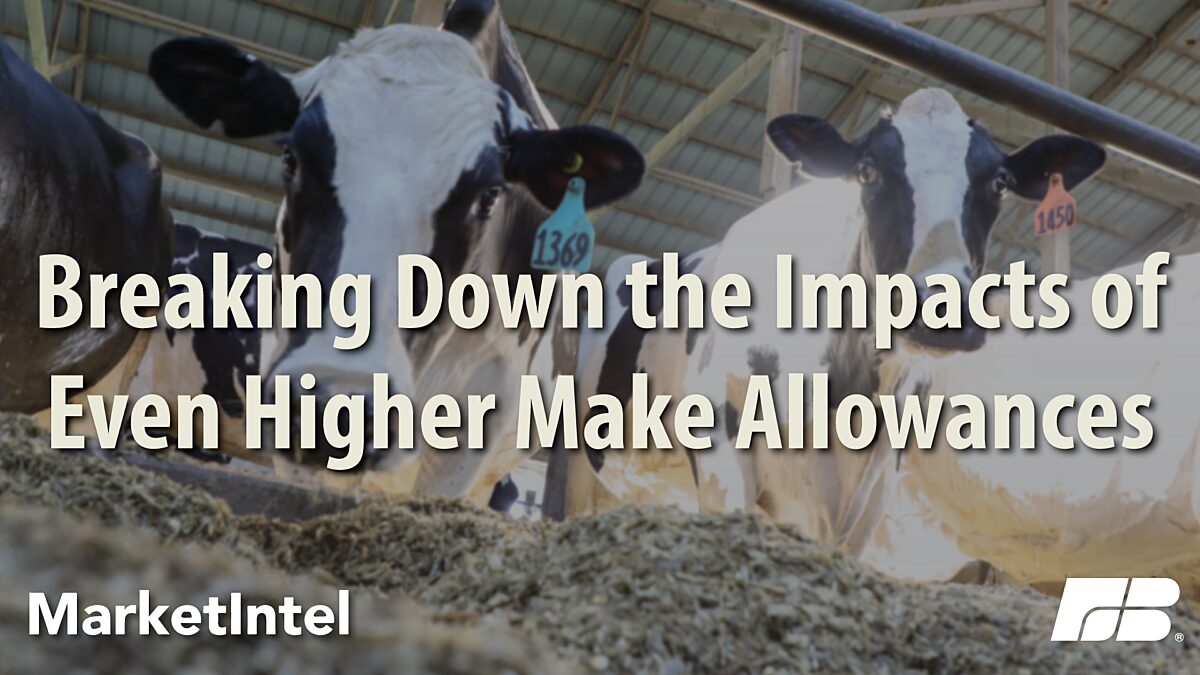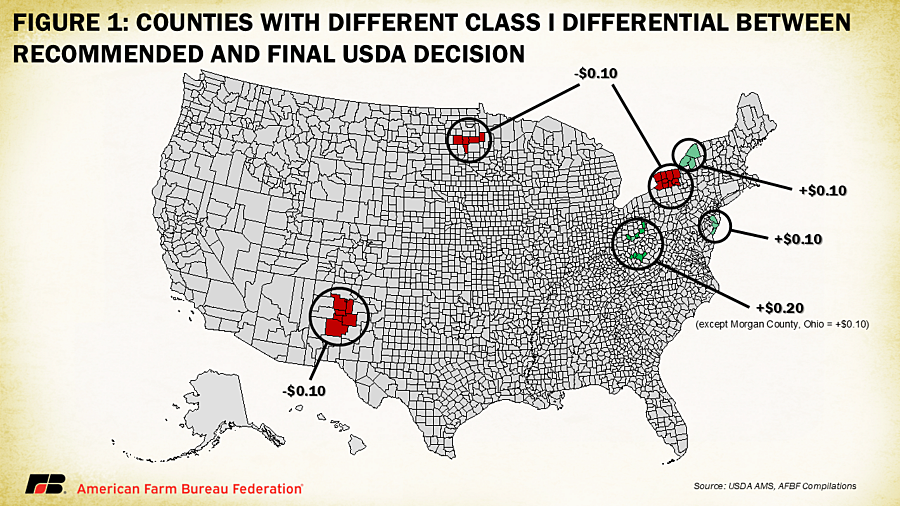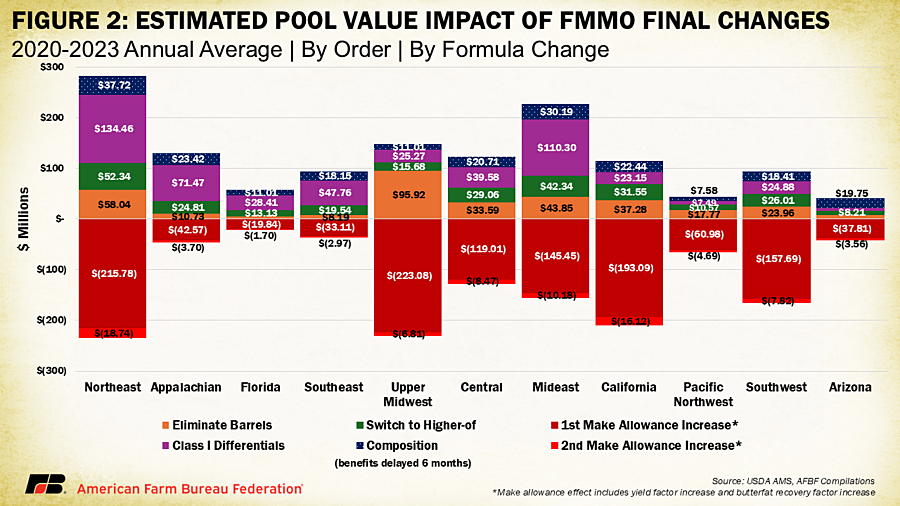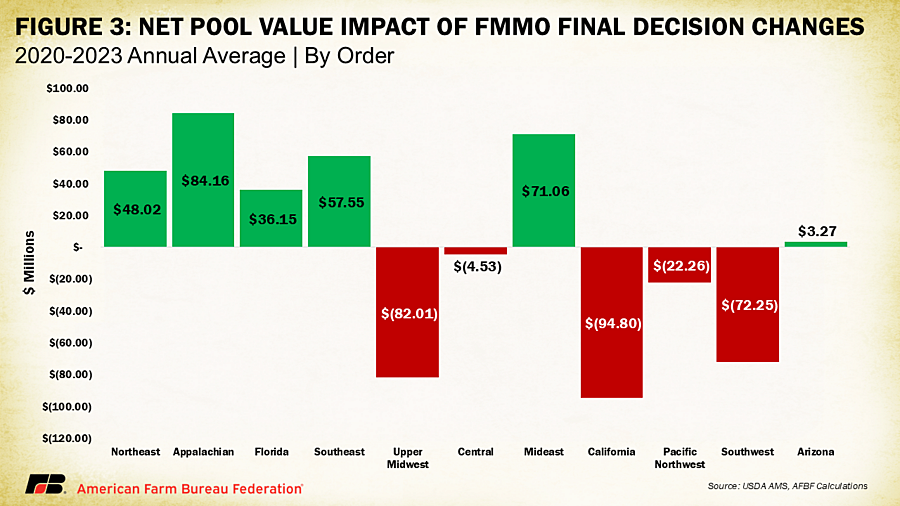From Proposed to Final: Unpacking USDA’s FMMO Decision
TOPICS
FMMO
Daniel Munch
Economist
USDA- Agricultural Marketing Service’s (AMS) final decision on proposed amendments to the pricing formulas governing all 11 Federal Milk Marketing Orders (FMMOs), released Nov. 12, largely mirrors the recommended decision issued in July 2024 but includes adjustments driven by USDA's assessment that new comments and evidence justified changes — many of which appear to come at the expense of dairy farmers.
As the industry awaits the results of the USDA referendum, stakeholders are evaluating how these changes could impact milk pricing, market dynamics and profitability. This Market Intel breaks down the differences between the recommended and final decisions, estimates their pricing implications and highlights key considerations for dairy farmers.
Background
USDA’s final FMMO decision stems from a years-long effort to modernize milk pricing formulas and address issues that have emerged since the last major overhaul went into effect in 2000. Following testimony presented during a 49-day national hearing in Carmel, Indiana, from August 2023 to January 2024, and subsequent post-hearing briefs, USDA released its recommended decision in July 2024. This recommendation proposed changes to pricing formulas, including updates to milk composition factors, surveyed commodity products, make allowances, the Class I base price formula, and Class I differentials. These amendments aimed to address inefficiencies and better align pricing structures with market realities, though the proposals drew mixed reactions from stakeholders due to their varied regional and operational impacts. For a deep dive into the recommended decision please refer to Decoding USDA’s FMMO Recommendations – Extended Edition.
The final decision introduces changes to three amendments presented in the July recommended decision involving implementation of increased composition factors, increased make allowances and adjusted Class I differentials. The remaining amendments were presented unchanged in the final decision.
- Delayed Implementation of Composition Factors
In its recommended decision USDA increased the protein, other solids and total (nonfat solids) composition factors but proposed a 12-month delay in their implementation. This meant that while all other adjustments would take effect when the new order regulations are implemented, the increases in composition values would be postponed for a year. USDA claimed this delay would have allowed producers who use risk management tools, such as CME futures and Dairy Revenue Protection insurance, to adjust their positions and mitigate potential financial harm from regulatory changes.
In their final decision, USDA shrunk the 12-month delay in composition factor implementation by half, to six months. USDA argued the change was made to balance the needs of producers using risk management tools with the urgency of aligning prices with market conditions.
AFBF opposed the original delay, arguing that it unnecessarily prolongs the period during which producers are undercompensated for the higher-value milk they are already delivering. A static analysis of class price formulas from 2020 to 2023 indicates that updating composition factors would have generated an average cumulative annual benefit of $220 million for producers, meaning this delay could cost dairy farmers more than $100 million during the first six months alone. While the reduction from 12 months to six months is an improvement, it still deprives farmers of revenue during a time when fair compensation should be prioritized.
2. Increases to Make Allowances
USDA’s final decision introduced additional increases to all four make allowances beyond those in the recommended decision, exacerbating large negative impacts to dairy farmers’ milk checks. Make allowances provide for the costs incurred by processors to convert raw milk into finished products, such as cheese, butter, nonfat dry milk (NFDM) and dry whey. These allowances are deducted from the value of raw milk before calculating the prices paid to farmers. Higher make allowances generally result in a lower pay price to dairy farmers, all else being equal.
In addition to the increases outlined in the recommended decision, USDA added a $0.0015 per pound marketing cost factor into the make allowances for all four commodities. This addition reflects USDA's determination that post-packaging expenses — such as warehousing, transportation, and maintaining sales staff — are integral to the manufacturing process and had been inadvertently excluded from the recommended decision.
In addition to the $0.0015 increase in make allowances across all commodities, USDA revised the methodology for calculating the NFDM make allowance. The recommended decision initially relied on an average of Dr. Mark Stephenson’s 2021 cost of processing survey and 2016 data from the California Department of Food and Agriculture, reflecting California's significant role in NFDM production. However, stakeholders raised concerns about the outdated 2016 data and methodological issues with the 2021 survey. In response, USDA substituted the 2016 data with Dr. Stephenson’s updated 2023 low-cost processing survey results. This change increased the NFDM make allowance by 1.1 cents, even before the addition of the marketing cost factor.
If the final increases in make allowances, butterfat recovery factor and butterfat yield factor in cheese had all been implemented between 2019 and 2023, they would have reduced Class I prices by an average of 87 cents/cwt; Class II prices by an average of 85 cents/cwt; Class III prices by 90 cents/cwt; and Class IV prices by 85 cents/cwt. These final adjustments represent additional reductions compared to USDA's recommended decision of 6 cents less for Class I, 11 cents less for Class II, 2 cents less for Class III and 11 cents less for Class IV.
Across all 11 FMMOs, these additional allowances for manufacturers would have led to an average annual pool value loss of over $91 million—on top of the already substantial $1.26 billion decline projected from the recommended decision’s initial increases. These adjustments underscore the significant financial impacts on dairy farmers in all markets.
AFBF continues to oppose both the initial and final make allowance increases, arguing that adjustments must be grounded in comprehensive, mandatory and independently audited surveys. Without such data, there is some likelihood that USDA’s changes will unfairly penalize dairy farmers by overstating processing costs. The topic of unfair survey bias was explored more in-depth here and is accessible in AFBF’s final comments to USDA’s recommended decision.
3. Class I Differentials
USDA’s recommended decision proposed increases to all Class I differentials, except for two counties in southwest Oklahoma. After digesting additional comments from stakeholders, USDA made changes in the final decision to Class I differentials in 37 counties across seven states. The adjustments ranged from a reduction of 10 cents across 22 counties, to an increase in 10 cents across seven counties and an increase of 20 cents in eight counties (Figure 1).
USDA claims the adjustments within the final decision reflect updated economic realities and aim to ensure equity among producers and handlers. The changes account for increased transportation costs, the perishability of milk, and market consolidation, which has resulted in fewer plants and greater distances between supply and demand. Localized factors, such as urban service costs and historical price relationships, also informed USDA’s adjustments. For a deep dive into Class I differentials please refer to: Milk Price Differentials Long Overdue for an Update.
In comments on the recommended decision, some regional producer groups raised concerns about the overall adjustments to Class I differentials and the additional location-based adjustments that directly affect producer payments in all markets.
Class I differentials are added to a base Class I price to determine the minimum Class I milk price for each location. In addition, when milk is priced at a specific plant, an adjustment for plant location is also applied to producer milk. This producer location differential reflects the difference between the Class I differential at the location where a producer delivers their milk and a reference (or base) zone assigned to a federal order, such as Jackson County (Kansas City, Missouri) in the Central order. The uniform price of milk represents the weighted average price of all producer milk across all classes, but the producer location differential adjusts this price based on where the milk is delivered. This adjustment, whether negative or positive relative to the base zone, increases or decreases the uniform price a dairy farmer ultimately receives. In addition to raising Class I differentials in most locations, USDA’s recommended and final decisions also alter producer location differentials in many areas. In some cases, the changes flip the producer location differential from positive to negative, leading to potential comparative — and in some cases absolute — losses for farmers delivering milk in those counties.
For example, the current base Class I differential in Jackson County, Missouri, is $2 per hundredweight, and the proposed change increases it to $3.20. Under the updated decision, if a plant in another part of the order (such as El Paso County, Colorado) now has a differential 50 cents lower than Jackson County, the adjusted Class I differential for that location would be $2.70. While this represents an increase from the current $2.55 differential in El Paso County, Colorado, and an increase in the Class I price that a bottling plant must pay, it also marks a comparative loss relative to Jackson County under the new pricing structure. Historically, plants in Colorado had differentials 35–55 cents higher than Jackson County, providing producers a price bump from the base uniform price. The proposed changes flip this dynamic, with Colorado differentials now 50–70 cents lower, creating a net comparative loss of $1.15 per hundredweight on all milk in those locations, outweighing any uniform price gains from the increased Class I differentials. Simply put, while USDA projects an increased uniform price for Kansas City in Federal Order 32, the overall uniform price across the market is expected to decrease. For Colorado, in particular, the new rules make it highly likely that the uniform price will be lower than before.
Putting it All Together
One of the key elements of the FMMO system is its pooling mechanism, which ensures that farmers receive a uniform price for their milk, regardless of what it is used for. The intention is to ensure handlers in a similar location and who produce similar products pay the same minimum classified price for raw milk and that farmers producing milk in the same area receive the same price (i.e., uniform pricing). Each month, the total class values of milk within an order are aggregated, and an average uniform price is calculated. The contributions of different class prices to the pool can vary significantly depending on the supply and demand conditions within an order. Consequently, the effects of adjustments to class price formulas on individual orders are best understood once differences in class utilization and production volumes are accounted for.
Figure 2 illustrates the annual impact of each of USDA's final amendments on the total pool value for each order (using an average across 2020-2023 pricing data). In this analysis, each adjustment was made separately and then layered to isolate the effect of each recommendation. However, it's important to note that interactions between different formula factors within the Class price equations were not considered, so the combined effects of these adjustments in real-world scenarios might differ.
Most important in this analysis, the proposed further increases in make allowances (labeled “2nd make allowance increase”) have additional negative impacts to order pool values, ranging from a pool value impact of -$1.7 million in the Florida Order to -$18.7 million in the Northeast Order. All other adjustments positively impact pool values. Composition factor updates contributed to a half-year increase of $110 million across all orders, a benefit that would be inaccessible for the first six months due to the final six-month implementation delay. The proposed extended shelf life adjustment for the base Class I price was not included as the overall impact on pool values was too minor to visualize.
Figure 3 combines the effects of USDA’s FMMO recommendations and shows the net impact on each order. The proposed increases in make allowances would significantly reduce the total pool value in several orders, with losses of $94 million in the California order, $82 million in the Upper Midwest order, $72 million in the Southwest order, and $22 million in the Pacific Northwest order. Notably, the Central order would flip from a $3.9 million gain to a $4.5 million loss, underscoring the significant impact of even minor formula changes. Had these adjustments been in place from 2020 to 2023, dairy farmers in these five orders — characterized by higher Class III and IV utilization — would have received lower prices compared to the current system. In contrast, orders with higher Class I utilization, such as the Appalachian and Mideast orders, would see increased pool values, while Arizona would experience a small positive gain. These proposed changes create new regional disparities among dairy farmers, undermining the FMMO system’s goal of equitable treatment across locations.
What Happens Next
Votes are currently being counted by USDA’s AMS to determine whether or not dairy farmers and cooperatives have voted to approve or reject the amendments in each of the 11 orders. USDA will continue to count ballots that were postmarked by Dec. 31 and received by Jan. 15. If the ballots indicate approval by at least two-thirds of the producers or two-thirds of the milk volume within an order, USDA will issue a final rule in the Federal Register specifying which amended orders have been approved or rejected in their entirety. (USDA chooses to automatically terminate orders if their amendments are not approved, something AFBF generally opposes.)
Implementation of the approved amendments is expected to occur no earlier than late second quarter, allowing for at least 30 days' notice before the changes take effect. All changes will apply to milk marketed on or after the first of the month following the implementation date (aside from the delayed composition factor updates). However, the implementation timeline could be delayed if lawsuits are filed. Historically, lawsuits can result in a stay of the new orders, keeping the current provisions in place until the litigation process is resolved. For more information on how the referendum process works, please read Understanding the FMMO Referendum Process and watch USDA’s webinar.
Top Issues
VIEW ALL





